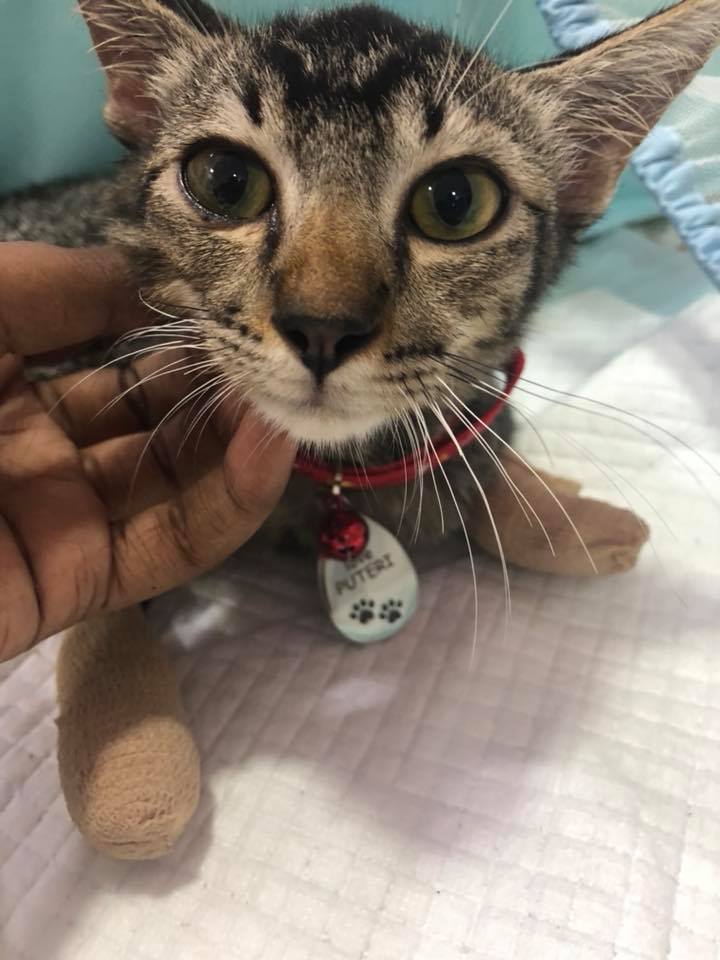KUALA LUMPUR, Aug 27 — When animal rescuer Daachayeni Arivalagan shared a video of a badly abused kitten on Facebook in July, almost 4,000 people shared it and enough funds were raised to pay for its medical treatment.
“A man found the kitten in a drain in Shah Alam with its four paws cut off by an unidentified person. He then contacted me to help the kitty,” she told Bernama, when contacted.
The kitten, named Puteri by its rescuer, was five months old. Netizens were, of course, outraged when photographs and videos of the kitten were circulated on Facebook.
Puteri, which has since been adopted by Daachayeni, is now recovering from surgery and is eating well too. With the tender loving care of its new owner, the kitten will soon overcome the trauma it had been through.
According to Veterinary Services Department statistics, the number of cases involving animal abuse increased by 10 per cent from 463 in 2016 to 510 cases last year. About 90 per cent of these cases involved dogs and cats.
Dr Salehatul Khuzaimah Mohamad Ali, who runs a veterinary clinic in Shah Alam, said animal abuse can either be direct or indirect.
Direct abuse means ill-treating or torturing the animal by scalding it with hot water or hot oil or beating it or even poisoning it.
“In our clinic right now, we are treating a cat which we suspect was abused. When it was brought to the clinic, it had been scalded,” she said, adding that the cat, nicknamed Skin, has been receiving treatment in her clinic for almost six months.
Indirect abuse, she added, takes place when the owner fails to provide his or her pet with its basic needs like food and shelter.
“When the pet owner doesn’t feed his or her pet, that’s a form of abuse too,” said Salehatul Khuzaimah, who has appeared on TV Alhijrah and IKIM FM radio station to talk about animal welfare issues.
Another situation of indirect abuse is when the owner does not take his or her sick pet to a veterinary clinic for treatment, she said.
Keeping a pet enclosed in a small cage all the time also amounts to indirect abuse. Cages are allowed as long as they are spacious and comfortable for the animal to move around or sleep.
The Society for The Prevention of Cruelty to Animals (SPCA), meanwhile, is doing its part to help animals, including strays, in distress or are being abused.
SPCA Education and Events Officer Arief Fauzy said the organisation was creating awareness on responsible pet ownership.
“Having a pet is more than just feeding and housing them. It’s also about taking care of their welfare and enriching their lives,” he said.
In 2016, 676 cats and dogs were surrendered or abandoned at SPCA, with the number rising to 935 last year.
Commenting on the increasing number of pets that are abandoned by their owners, animal welfare group Sahabat Kucing Jalanan chairman Mohd Rosli Mohd Ariffin said the government should introduce new regulations to make it compulsory for owners to vaccinate, neuter and implant a microchip in their pets.
“By Inserting the microchip, which will have the owner’s identification, it will be easier for the local councils to detect the owner of the abandoned animal,” he said, adding that a penalty should be imposed on owners who abandoned their pets.
To deal with the rising number of animal abuse cases, SPCA is making an effort to create ‘Caring and Compassionate Communities’ (CCC) to establish safe zones in housing areas where the spayed/neutered animals can live their lives free from captivity and misery.
Through CCC, the local community will be encouraged to set up feeding stations for strays in their area, as well as spay/neuter them with SPCA’ s assistance. — Bernama



















